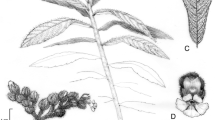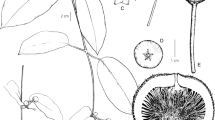Abstract
A new species, Hyptidendron roseum, from the Chapada dos Veadeiros region, Goiás state, is described and illustrated. It can be distinguished from its congeners by the combination of inflorescences composed of a unilateral cymose structures, sessile to subsessile leaves, a ring of trichomes in the throat of the calyx tube, and a dense indumentum of white uniseriate trichomes covering much of the plant. The new species is compared with similar species such as H. unilaterale and H. albidum. New specimens of another species, H. unilaterale, formerly known only from the type, were identified in herbaria and collected in the field. Photos in vivo of this species are provided for the first time, accompanying a full description and an illustration. We assess its conservation status and comment on its distribution, ecological aspects, and identification.





Similar content being viewed by others
Literature cited
Alves, R.J.V., N.G. Silva, J.A. Oliveira & D. Medeiros. 2014. Circumscribing campo rupestre – megadiverse Brazilian rocky montane savanas. Brazilian Journal of Biology 74: 355–362.
Bachman, S., J., A.W. Moat, J. de la Torre Hill & B. Scott. 2011. Supporting Red List threat assessments with GeoCAT: Geospatial conservation assessment tool. ZooKeys 150: 117–126. Available at; www. http://geocat.kew.org/ (Version BETA).
BFG – The Brazil Flora Group. 2015. Growing knowledge: an overview of seed plant diversity in Brazil. Rodriguésia 66: 1085–1113.
Epling, C. 1949. Revisíon del gênero Hyptis (Labiatae). Revista del Museo de La Plata (Bot.) 7: 153–497.
Harley, R. M. 1986. Notes on New World Labiatae VIII. New species of Hyptis (Labiatae) from South America. Kew Bulletin 41: 41–150.
Harley, R. M. 1988. Revision of generic limits in Hyptis Jacq. (Labiatae) and its allies. Botanical Journal of the Linnean Society 98: 87–95.
Harley, R. M. 2013. Notes on the genus Gymneia (Lamiaceae: Ocimae, Hyptidinae) with two new species from Brazil. Phytotaxa 148: 57–64.
Harley, R. M. & G. M. Antar. 2017. Hyptidendron albidum (Lamiaceae, Hyptidinae), a remarkeble new species from northern Minas Gerais state, Brazil. Phytotaxa 308: 97–103.
Harley, R. M. & J. F. B. Pastore. 2012. A generic revision and new combinations in the Hyptidinae (Lamiaceae), based on molecular and morphological evidence. Phytotaxa 58: 1–55.
Harley, R. M. , S. Atkins, A. Budantsev, P. D. Cantino, B. J. Conn, R. Grayer, M. M. Harley, R. de Kok, T. Kretovskaja, R. Morales, A. J. Paton, O. Ryding & T. Upson. 2004. Labiatae. Pp. 167–275. In: J. W. Kadereit (ed.), The families and genera of flowering plants. 7. Lamiales (except Acanthaceae including Avicenniaceae). Berlin, Springer.
Harris, J. G. & M. W. Harris. 2001. Plant identification terminology: an illustrated glossary. Second edition. Spring Lake Publishing, Spring Lake, USA.
Hickey, L. J. 1973. Classification of the architecture of dicotyledonous leaves. American Journal of Botany 60: 17–33.
IUCN (International Union for the Conservation of Nature and Natural Resources). 2012. IUCN Red List categories and criteria: Version 3.1. Second edition. IUCN, Gland, Switzerland and Cambridge, UK.
IUCN Standards and Petitions Subcommittee. 2017. Guidelines for using the IUCN Red List categories and criteria. Version 13. Downloadable from: http://www.iucnredlist.org/documents/RedListGuidelines.pdf.
Pastore, J. F. B., R. M. Harley, F. Forrest, A. J. Paton & C. van den Berg. 2011. Phylogeny of the subtribe Hyptidinae (Lamiaceae tribe Ocimeae) as inferred from nuclear and plastid DNA. Taxon 60: 1317–1329.
QGIS Development Team. 2018. QGIS Geographic information system. Open Source Geospatial Foundation Project.
Rudall, P. J. 1980. Leaf anatomy of the subtribe Hyptidinae (Labiatae). Botanical Journal of the Linnean Society 80: 319–340.
Thiers, B. (continuously updated). Index herbariorum: a global directory of public herbaria and associated staff. New York Garden's Virtual Herbarium. Available from: http://sweetgum.nybg.org/ih/ herbarium.php?irn=174420 (accessed: 8 May 2017).
Acknowledgements
We thank Monique Rached for providing the illustrations; curators of the herbaria visited; Bárbara de Queiroz Carvalho Zimbres, Daniel Augusto Chaves and Gustavo Mariano Rezende for help during field work; GMA thanks CAPES, ASPT and Idea Wild for financial support and the Smithsonian Institute for the Cuatrecasas Fellowship Award which made it possible to see most of the type material of Hyptidendron species; RMH would also like to thank the staff of the Kew Herbarium, for their support; PTS thanks CNPq for financial support (grant#150217/2016-1, grant#310437/2015-6) and JFBP thanks CNPq for financial support (grant#302452/2017-1).
Author information
Authors and Affiliations
Corresponding author
Rights and permissions
About this article
Cite this article
Antar, G.M., Harley, R.M., Pastore, J.F.B. et al. Novelties in Hyptidendron (Hyptidinae – Lamiaceae) from Brazil: A new species and a rediscovery. Brittonia 71, 64–72 (2019). https://doi.org/10.1007/s12228-018-9550-4
Published:
Issue Date:
DOI: https://doi.org/10.1007/s12228-018-9550-4




